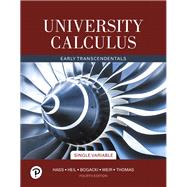NOTE: Before purchasing, check with your instructor to ensure you select the correct ISBN. Several versions of the MyLab™ and Mastering™ platforms exist for each title, and registrations are not transferable. To register for and use MyLab or Mastering, you may also need a Course ID, which your instructor will provide.
Used books, rentals, and purchases made outside of Pearson
If purchasing or renting from companies other than Pearson, the access codes for the MyLab platform may not be included, may be incorrect, or may be previously redeemed. Check with the seller before completing your purchase.
For 2-semester or 3-quarter courses in single-variable calculus for math, science, and engineering majors.
This package includes MyLab Math.
Clear, precise, concise
University Calculus: Early Transcendentals, Single Variable helps students generalize and apply the key ideas of calculus through clear and precise explanations, thoughtfully chosen examples, meticulously crafted figures, and superior exercise sets. This text offers the right mix of basic, conceptual, and challenging exercises, along with meaningful applications. In the 4th Edition, new co-authors Chris Heil (Georgia Institute of Technology) and Przemyslaw Bogacki (Old Dominion University) partner with author Joel Hass to preserve the text’s time-tested features while revisiting every word, figure, and MyLab™ question with today’s students in mind.
Personalize learning with MyLab Math
By combining trusted author content with digital tools and a flexible platform, MyLab Math personalizes the learning experience and improves results for each student.
0135308046 / 9780135308042 University Calculus, Single Variable plus MyLab Math with Pearson eText - Access Card Package
Package consists of:
- 0135164842 / 9780135164846 University Calculus: Early Transcendentals, Single Variable
- 0135183715 / 9780135183717 MyLab Math with Pearson eText - Standalone Access Card - for University Calculus: Early Transcendentals








